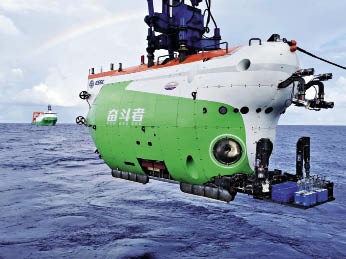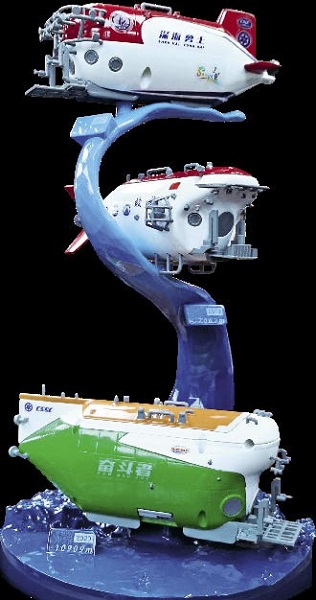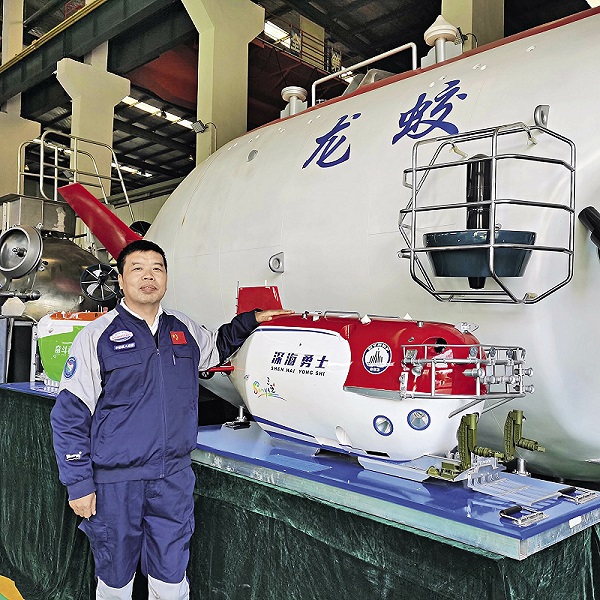China's deep-sea manned submersible Fendouzhe (Striver) made national history on November 10, 2020, when it descended 10,909 meters into the Mariana Trench in the western Pacific Ocean. Chinese President Xi Jinping sent a congratulatory letter marking the feat, in which he said the successful expedition showed China is capable of conducting scientific exploration and studies in the deepest depths of the ocean.
For nearly two decades, scientists and engineers have had their own career intertwined with China’s deep-sea diving cause. Thanks to their dedication, China has witnessed considerable improvements in ocean-exploration craft from its first deep-sea manned submersible Jiaolong to Shenhai Yongshi (Deep Sea Warrior) whose key equipment was domestically produced, and the Fendouzhe which just concluded the new record-making mission.

China’s deep-sea manned submersible Fendouzhe.
Starting from Scratch
Hu Zhen, chief engineer at China State Shipbuilding Corporation, is deputy chief designer of the submersible Fendouzhe. He first heard of Russia’s submersible Mir in 1992 at a meeting discussing the feasibility of building deep-sea manned submersibles in China. The Mir became a hot topic when research development in foreign countries was discussed. The Russian submersible was capable of diving to depths of 6,000 meters. Since then, many researchers like Hu Zhen had dreamed of building China’s own “Mir.” That year, the Chinese government consulted scientists across the country for the future direction of scientific research regarding the ocean. In 1995, China successfully tested the CR-1 autonomous underwater vehicle designed by the Xu Qinan-led team, laying a technological foundation for following manned deep-sea diving missions.
In January 2000, China Ocean Mineral Resources R&D Association organized a panel session attended by 10 academicians and 15 professors in oceanic research. They agreed that developing manned submersibles was the future direction of scientific research. In February 2001, their suggestion was submitted to the Ministry of Science and Technology. During the same year, China Ocean Mineral Resources R&D Association gained an exploration license for a polymetallic nodules mining area measuring 75,000 square kilometers in the eastern Pacific Ocean. This offered manned submersibles targeted end users and demands. In mid-2002, the Ministry of Science and Technology approved the program of building a manned submersible.
It was named Jiaolong after the mythical sea dragon in Chinese folklore. The first deep-sea manned submersible was designed to dive as deep as 7,000 meters underwater.
Water pressure in the deepsea tests the submersible’s pressure structures manufacturing technology to their limits. Every additional meter of depth means that water pressure on the pressure structures rises by one ton. Plunging 7,000 meters deep underwater means the submersible has to handle water pressure weighing 7,000 tons. The hatch cover, which seems inconspicuous, is dubbed “the door to the deep sea” by the research team. Under high water pressure, if water seeps into the atmospheric pressure hull through the hatch cover, the water ejection speed is even faster than the velocity of a bullet.
Another challenge is underwater communication. Messages can only be delivered via sonic wave rather than radio wave in the deep sea. Yang Bo, a researcher at the Institute of Acoustics of the Chinese Academy of Sciences, said that the squeaking of dolphins or the lapping of waves could cause confusion in communication. As the global positioning system is not effective underwater, the Jiaolong submersible had to be equipped with a new acoustic positioning system. The control system was also vital as it must enable automatic cruise as well as stable hovering when the robotic arms in operation.
Apart from dedicated accumulator batteries, manipulators, and thrusters, other commonly used parts on land including electric motors, pumps, and valves had to be adapted for the underwater environment.
On September 1, 2007, the blueprint of Jiaolong finally became a reality. When it was tested underwater in August 2009, its chief designer Xu Qinan insisted on boarding the support ship to command it personally despite his medical condition.
“Jiaolong integrates the world’s cutting-edge technologies in deepsea exploration,” said Xu. “Its completion symbolizes that we have had internationally recognized key technologies for manned submersibles in our hands.”

A deep-sea submersible model.
A Step Backward
As China went deeper in the sea, one Jiaolong submersible was far from enough to explore the mysterious underwater world. In 2009, China initiated study on a second deep-sea manned submersible – the Deep Sea Warrior. This time, scientists decided that the new submersible should go shallower, but that 85 percent or more of its key technologies should be independently developed.
This was a daunting challenge. The first conundrum to crack was the accumulator batteries, which are vital to the safety of the watercraft. Jiaolong used domestically produced silver-zinc batteries, which were expensive and could only provide power for a year. The Deep Sea Warrior was expected to use improved oil-filled pressure-compensated lithium-ion batteries.
Around 2013, Hu Zhen was leading a team to test the pressure-resistant performance of the batteries. Unexpectedly, a battery broke down. “We then swiftly shifted our focus from making it the most sophisticated to making it safe. In the meantime, we improved the design and production process,” Hu recalled. A battery set is usually made up of several hundred cells. The research team had to test each cell for around 20 pressurization and depressurization cycles to make it safe. The testing of the cells lasted three months. Then, the engineers assembled the cells into a battery set and tested its discharge performance in a high-pressure environment.
In 2014 and 2016, the assembling and sea trial of the Deep Sea Warrior were initiated respectively. From the pressure hull to the lithium-ion battery and the ultrahigh-pressure sea water pump, the submersible prototype integrated a lot of domestically-produced equipment.
The years from 2012 to 2014 were the toughest period for Hu Zhen. Although his team made progress in some areas, the prototype was far from ideal. The project scheduled to be finished in 2015 had to be postponed.
“The working environment of deep-sea submersibles is very harsh and complicated. Due to our limited industrial production capacity, there was still a huge gap between the technology and the integrated submersible,” Hu said. Some problems were minor, but would compromise the life expectancy of the deep-submergence vehicle, according to Hu. He slowed down the research project and dedicated more energy to ensure that technical indicators were met.
After eight years of hard work, Chinese scientists became capable of independently developing 10 key components of the submersible, which are the pressure hull, buoyancy materials, lithium-ion batteries, thrusters, sea water pumps, manipulators, the hydraulic system, acoustic communication system, underwater positioning system, and control software. “As of December 4, 2020, the battery we developed had powered the Deep Sea Warrior’s 310 diving missions,” Hu said.
The success of Deep Sea Warrior and Jiaolong boosted researchers’ confidence in going down deeper towards the seabed.
Down to the Bottom
In late 2017, Lü Yifan, chief welding technician for Fendouzhe, was racking his brain for a solution to meet a welding technical indicator. With available techniques, his team had reached their limit. No matter how they adjusted the parameters, they could not meet the key indicator.
Lü boldly proposed a new electron beam welding technique that had not been applied internationally. But the application of the new technique needed a special system. Lü and his team tried numerous rounds, without results. However, the failure did not diminish Lü’s faith in the method. They continued the research and finally designed a well-functioning support system. This led to the success of welding the pressure hull, a landmark in the research and development of the submersible.
The following conundrum was materials for the deep-submergence vehicle. Diving in deep sea, the submersible has to handle 1,000 units of atmospheric pressure, which amounts to bearing the pressure equivalent to being trampled by 2,000 African elephants. The Institute of Metal Research under the Chinese Academy of Sciences offered a solution. Newly designed titanium alloy materials could be used to build a pressure hull that would be able to withstand the high-pressure underwater environment and be easy to weld.
In the sea trial in 2020, Fendouzhe had a well-managed pace of diving. For plunges to 5,000 meters, 7,000 meters, and 8,000 meters; each attempt was made on consecutive separate days. Then after reaching the depth of 9,000 meters, the watercraft dived on every other day; when the depth up to 10,000 meters, the interval for plunges extended to two days. More importantly, many parts of the equipment recorded zero malfunctions.
Hu Zhen attributed the success to meticulous design and repeated tests. “It fully proves the maturity of China’s manned submersible technology, equipment, and research teams,” Hu said.
“Dear friends, the bottom of the sea is incredible,” three researchers onboard Fendouzhe told the world via the underwater acoustic communication system on November 10 from the bottom of the Mariana Trench.

Hu Zhen, chief engineer at China State Shipbuilding Corporation, is chief designer of the submersible Deep Sea Warrior.
More Than an Adventure
Engineer Ye Cong is better known as a “deep-sea taxi driver.” Speaking of the reason for his yearning to steer the watercraft, Ye said an engineering designer can only depend on data recorded in the watercraft, but if he went underwater personally, he could connect the data with the real-life scenes and come up with better ideas to improve the practicability and design method of the submersible.
Ye said deep-sea manned diving is not about being an adventurer. “You need to be brave, but more importantly you should be down-to-earth to ensure everything goes smooth,” Ye said.
During the 2020 sea trial, the support ship carrying Fendouzhe met two typhoons and multiple cyclones. Many people onboard suffered from seasickness along the bumpy journey to the western Pacific Ocean. Even so, the Chinese pilots began diving merely hours after they arrived above the Mariana Trench. On October 27, 2020, Ye Cong witnessed the submersible diving to a depth of 10,000 meters from the starboard of Fendouzhe. There were no celebrations or tears of joy at the historic moment as often seen in films. The pilots onboard celebrated the moment with a dish of fried rice with scrambled eggs. “We were kind of light-hearted as we faced our success,” Ye said, given what researchers like him had devoted.
CHEN YU is a reporter with the Science and Technology Daily.